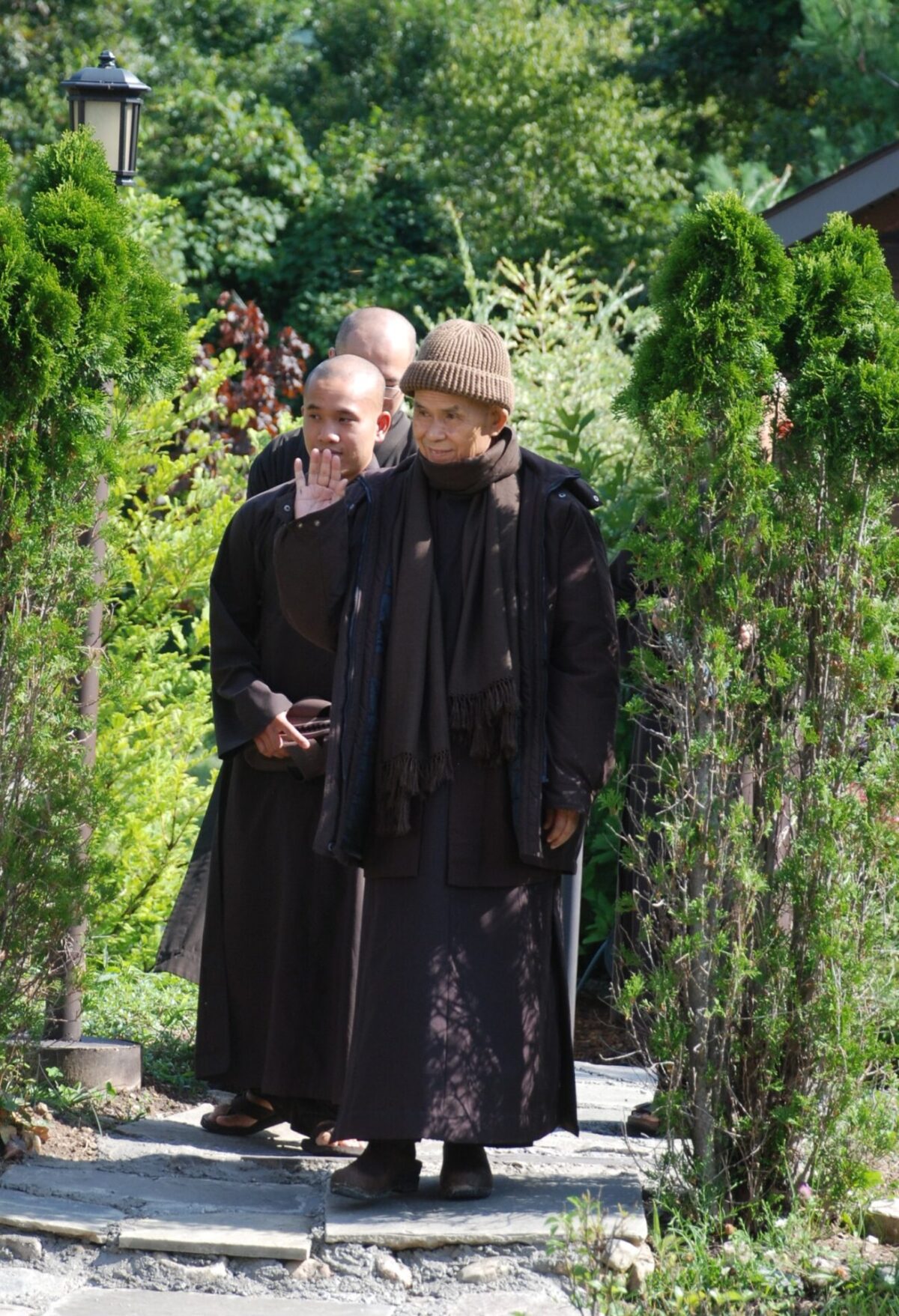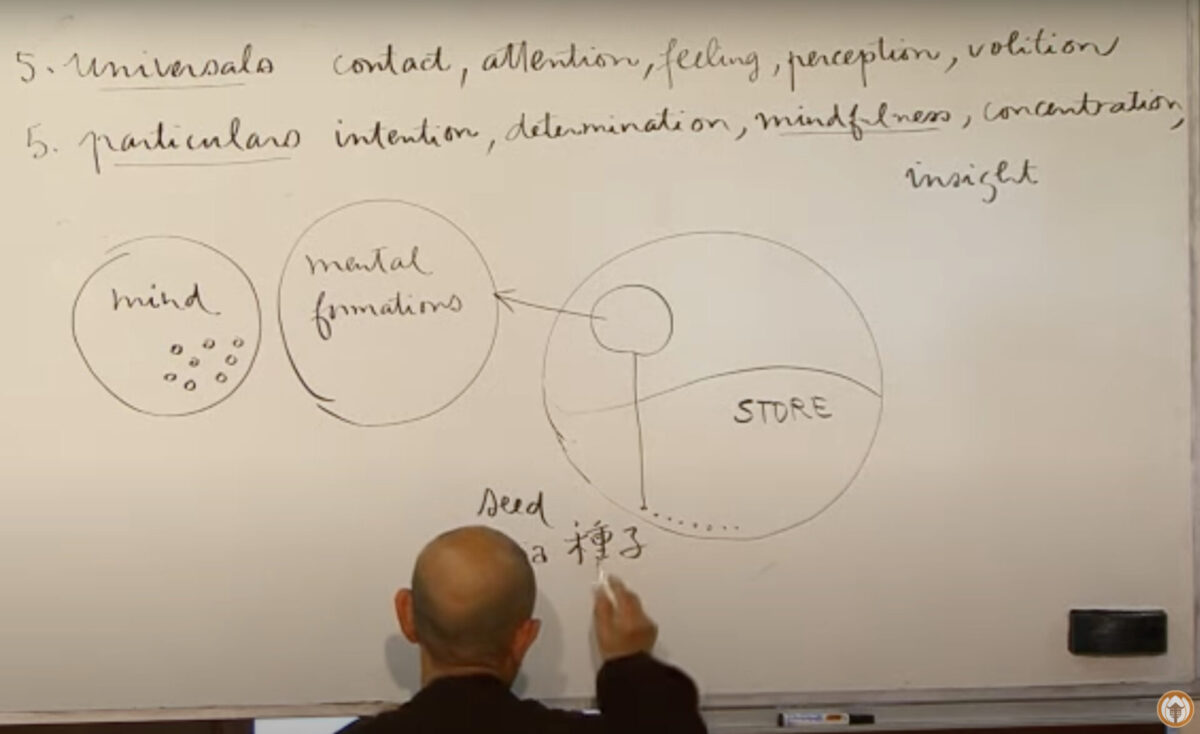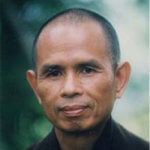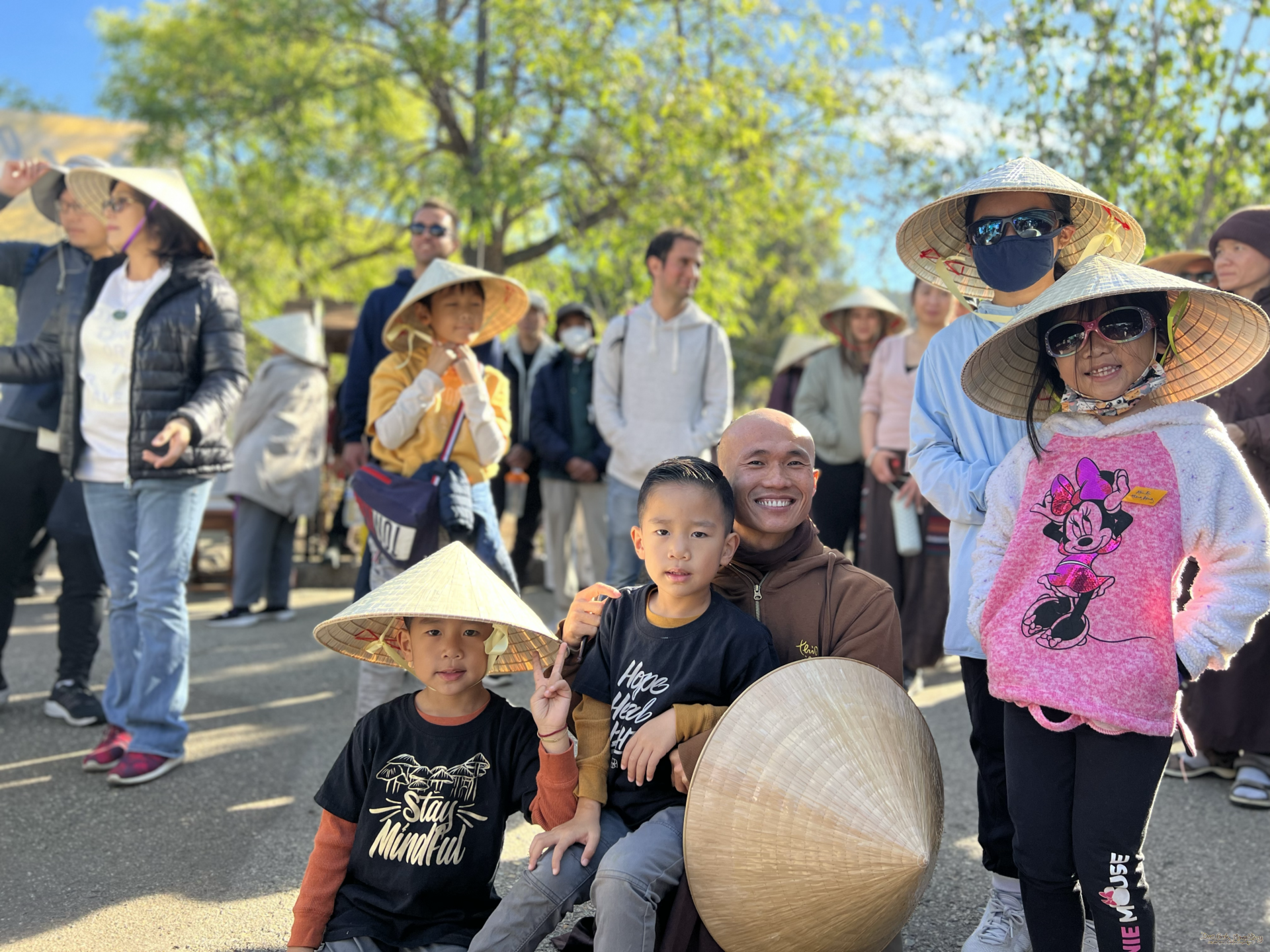Thích Nhất Hạnh teaches us to stop running and find healing, peace, joy, and happiness in our breathing and our walking.
By Thich Nhat Hanh on
When we practice mindfulness, every practice should be the healing itself. Suppose you are practicing mindful breathing. You think that the breathing will bring healing, but you have to breathe in such a way that every breath is healing itself.
Thích Nhất Hạnh teaches us to stop running and find healing, peace, joy, and happiness in our breathing and our walking.
By Thich Nhat Hanh on
When we practice mindfulness, every practice should be the healing itself. Suppose you are practicing mindful breathing. You think that the breathing will bring healing, but you have to breathe in such a way that every breath is healing itself. It is not a means, it is an end. If we breathe an in-breath and feel calm and pleasant, then the healing is there. But if you suffer and you have to make a lot of effort to breathe in, that is not healing. An in-breath can be healing or not, depending on the way we breathe. Mindful breathing means that while breathing in we are mindful of our in-breath. Mindfulness is the content of our in-breath.
Learning to stop
We have a habit of running, and this habit may have been transmitted to us by our parents and our ancestors. We run because we are not comfortable in the here and the now. We are running to look for something to make us happier, and behind that running there is a belief that happiness is not possible here and now. So we run into the future looking for more conditions of happiness. We run but we do not know that we are running because running has become a kind of habit energy pushing us. When you breathe in mindfully but cannot stop the running, then your in-breath does not have the power to heal. For healing to take place, your in-breath has to be able to stop you from running. You learn to take an in-breath in such a way that it becomes so pleasant that you can keep your attention on it. You breathe in in such a way that you find peace, happiness, and joy in your in-breath. If you can do that, then you can stop running. But if you breathe in with the purpose or the desire to get something out of your in-breath—such as health—you are still running.

Breathing is an art. You learn to breathe in so that your in-breath brings you peace, happiness, joy, and contentment; that is the only way to breathe so that you can heal. When you walk, you do the same thing: walking meditation helps you to stop running. If you walk with the idea of achieving something, you are still running. If you make a step and you are entirely satisfied with that step, if you find the joy, peace, and happiness that can nourish you, that is healing. So stopping the running is very important.
But you cannot stop just because you want to stop. The willingness to stop is not yet stopping. You need to have some insight to be able to really stop. It’s like relaxation: every one of us knows that relaxation is good for us. The tension in our body has been accumulating for a long time, and you want to relieve it. You have the desire to release the tension, and you try to do it, but you cannot—because the willingness to relax is not relaxation.
Hell and paradise are not elsewhere in space and time; they are inside you.
You need to have some insight to be able to relax and release the tension. That is why mindfulness has to be coupled with insight. Mindfulness is the kind of energy that helps you know what is going on in your body.
With mindfulness, if there is tension, you know there is tension. If there is pain, you know that there is pain. Mindfulness can help you see more deeply that you have a body, and that this body is a continuation of the body of your father, of your mother, and of your ancestors. If you keep your mindfulness alive, then you become more and more concentrated and you begin to see. You begin to have the kind of insight that can help you get out of your suffering, get out of your illusion, and help you to stop. Mindfulness is connected with concentration and insight; if you practice mindfulness well, you get concentration and insight at the same time.
Fifty-One Mental Formations
Everyone [in the Winter Retreat] will be receiving a sheet of paper that has the names of the fifty-one mental formations, and we are going to use that sheet of paper throughout the retreat. The first five mental formations are called the five universals. The first is contact, followed by attention, and then feelings, perception, and volition. After the five universals, you have the five particulars, which are intention, determination, mindfulness, concentration, and insight. We have been talking about mindfulness, which is one of the five particulars. When we speak of mind, we speak of something big like a river, the river of the mind. But the river is always made of drops of water and these drops of water represent mental formations. Mental formations are drops of water in the river of the mind.
[Drawing on the board] Our consciousness has at least two parts. The lower part is called the store consciousness, which holds and preserves many kinds of seeds. Every time a seed is watered, it manifests in the upper level of consciousness and becomes a mental formation.

You have a seed of anger down here and if it sleeps quietly, you are okay. But if someone says something that touches the seed of anger in you, then that seed becomes a mental formation. Down here it’s called a seed, a bīja in Sanskrit, 種子 in Chinese. When it becomes a mental formation, it’s called a citta saṃskāra. Mind is made of mental formations, also called caitta in Sanskrit, or cetasika in Pali.
So the seed is a kind of potential. Every one of us has a seed of anger within us, but even with sophisticated techniques, scientists cannot photograph the seed of anger in you. They cannot locate that seed in your consciousness, or in your brain. They cannot use imaging to recognize the seed of anger—even when you are sure that the seed of anger is in you. When that seed of anger sleeps calmly, you can laugh and have a good time, but that does not mean that seed of anger is not in you. It has not manifested, because it needs certain conditions to manifest. And even when these conditions manifest, it is difficult to capture an image of the seed in your brain.
You cannot locate this seed of anger in yourself—you don’t know where it is—but you know it is there. If it were not there, then you could not get angry. So the seed is a potential of a mental formation. It’s not local—you cannot point to where it is—and yet it is there.
You have fifty-one categories of seeds in your store consciousness. There are seeds that are good because they help you to be happy, to be generous, to be compassionate, and to have joy, but there are also unwholesome seeds like the seed of anger, displaced fear, and so on. They are all there. In store consciousness you have hell and you have paradise. Hell and paradise are not elsewhere in space and time; they are inside you. Sometimes paradise manifests and you are happy; sometimes hell manifests and you suffer. It’s like a television set of fifty-one channels, and it’s up to you to choose the channel. You can choose paradise or you can choose hell. You can choose to be a Buddha or you can choose to be a hungry ghost. It’s up to you. So that is store consciousness; that is the foundation of everything.
You have a seed of mindfulness down in store consciousness. Everyone has one; in bodhisattvas and buddhas, that seed of mindfulness is very robust, very strong. When they come into mind consciousness there is a lot of energy of mindfulness, and they can heal themselves and help heal other people. We are told in the Bible that Jesus had the power to heal, so he might have had a lot of mindfulness.
Mindfulness is the energy that helps you know what is going on: in your body, in your feelings, in your perceptions, and in the world.
In-breath is happening
Mindfulness is the energy that helps you know what is going on: in your body, in your feelings, in your perceptions, and in the world. When you practice mindful breathing, you recognize the closest thing that is going on—which is your in-breath. You are aware of your in-breath.
“Breathing in, I know I am breathing in.” The in-breath is happening. You recognize that you are breathing in; there is an in-breath going on: that is mindfulness. Many of us breathe in but do not know that we are breathing in; that is not mindful breathing. When you know that you are breathing in, that is practicing mindful breathing.
When you are aware of your in-breath, your mind is only on your in-breath and nothing else. You have a one-pointed mind: your mind has only one object, your in-breath. Mindfulness carries within itself the energy of concentration. If you maintain your mindfulness, concentration begins to build, and when mindfulness and concentration are powerful enough, you get insight. Insight can arise quickly—you don’t need hours, months, or years. If there is mindfulness and concentration, insight continues to come.
Suppose you are breathing in, concentrated on your in-breath, and you know “Ah, I am breathing in”—that is enlightenment already. “I’m alive because I am breathing in, because those who have died do not breathe in anymore. And since I am breathing in, I am alive.” “I am still alive” is an insight.
You are alive
To still be alive is a wonder—a miracle. People who do not know that they are alive are wasting their life. They are not living their life. Mindfulness reminds you that you are alive, and you should enjoy the fact that you are alive. That insight can bring joy in only a few seconds. Your in-breath may take three or four seconds, and during that time you are so concentrated on your in-breath that the insight comes, “Ah, I am alive, I am sitting here, I am walking on this beautiful planet.” That insight brings joy, and it has the power to liberate you from forgetfulness—the opposite of mindfulness. Mindfulness is written like this in Chinese, 念, and if you analyze it you see two parts: the above, 今, means the present moment, and the below, 心, means your mind. Your mind goes home to the present moment; this is mindfulness.
When you breathe in mindfully, you bring your mind home to your body, and you establish yourself in the present moment. When you establish yourself in the present moment, you know what is going on: that you are breathing in, that you have a body, and that you are alive. Mindfulness, concentration, and insight can come in just three, four, five seconds.
…healing is every breath, healing is every step.
Stop running
Say you want to release the tension in your body. With a lot of tension in your body you do not feel peace and happiness: you feel under pressure all the time because you have a habit of running. Breathing in, you recognize this habit energy of running in you. You can feel the habit energy pushing you to run into the future. If you can look deeply, you see that people are running after things like wealth, fame, power, and sensual pleasures because they think these things will bring them happiness. You may have gotten that idea from people around you or from your parents—the idea that without these things you cannot be a happy person. But with your insight you see that there are many, many people who are running after these objects of craving, and that doing so does harm to their bodies. They get sick, physically and mentally. Even those who have plenty of the things they have chased after are not happy people. There are many wealthy people with a lot of power and fame, and yet some of these people commit suicide. They are awfully lonely. This insight helps you to stop running, because you see that the running does not lead you anywhere, and that it can make you suffer. Only this kind of insight helps you to really stop.
Mindfulness with concentration will bring insight, and that insight helps you to stop. When you stop, you can easily release the tension in your body. When the habit energy of running was still pushing you, you found it difficult to do this. With the insight that chasing after these things does not bring happiness, you see that people who are running do not get anywhere, or that, even if they have gotten a lot of things they wanted, they still suffer. Only that kind of insight can help you really stop. When you stop, you can release the tension in your body easily. You enjoy breathing in and releasing the tension in your body.
Surrender to Mother Earth
If you breathe in and out like that, your in-breath and your out-breath are the healing itself—every breath is healing. When you practice walking meditation it is the same. When you take a step, you know that you are not looking for something in the future. You are not wanting to arrive anywhere; you just want to make a step and touch the wonders of life that are available in the here and the now. Making one step, you can stop the running and get in touch with Mother Earth, Father Sun, and the wonders of life. You touch healing, because nature has the power to heal and to nourish. If you do not stop running and allow your body and your mind to be embraced by nature—by Mother Earth—you don’t get the healing. When you take a step and surrender to Mother Earth, you stop running. You allow Mother Earth to embrace you and then you have the healing during your next step. So healing is every breath, healing is every step. You have to learn how to breathe and to walk like that.
This is an excerpt from the first Dharma talk of the winter retreat, November 17, 2013, in the Stillwater Meditation Hall, Upper Hamlet, Plum Village, France. Part 2 is available here. Listen to the full Dharma talk at https://tnhaudio.org/2013/11/19/rebuilding-health/.


